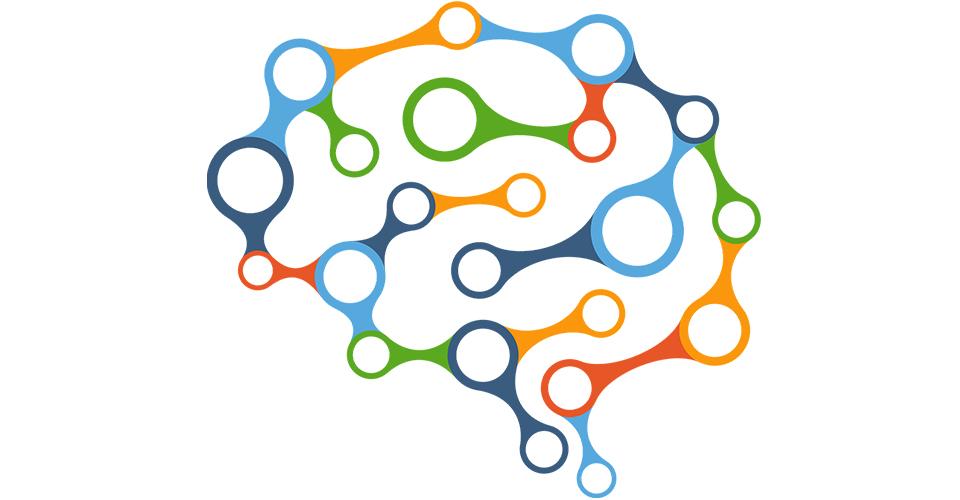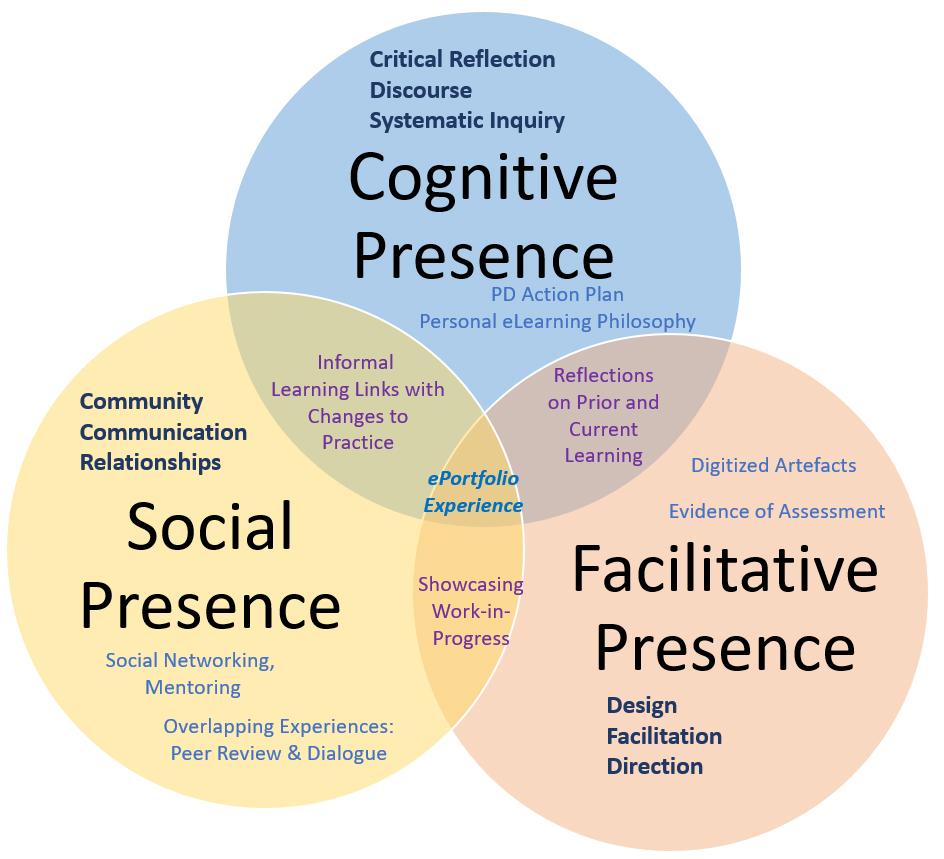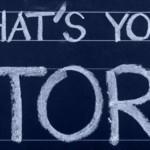
Roisin Donnelly
To continue the cycle of learning about ePortfolios, an important action that practitioners can take is sharing lessons learned from their professional practice. Readers of this article can follow ideas, thoughts and concerns from a decade’s experience of designing, implementing and evaluating an ePortfolio module aimed at lecturers, teachers, trainers and eLearning workplace practitioners across Ireland. The module has been delivered as a core part of an accredited Masters (MSc) professional development programme. Woven into the article is a reflexive commentary on how layers of teaching, cognitive and social guidance based on professional experience is formed. Benefit can be derived for learners, teachers and programme teams from the pedagogical content knowledge about ePortfolios shared here.
ePortfolio Context
Since 2007, when the two year part-time MSc Applied eLearning (90 ects) was first offered by the Learning, Teaching and Technology Centre in the Dublin Institute of Technology (DIT) as part of its accredited professional development provision, there have been 75 graduates from a wide variety of teachers from many subject disciplines in higher education and eLearning workplace professionals in Ireland. Demand for the MSc has remained consistent over the past five years, with an annual intake of 12‒15 students. Specifically, students on the programme are graduates of the Postgraduate Diploma in Third Level Learning and Teaching, lecturers from further and higher education institutions, training professionals in eLearning companies, individuals working in public agencies and eLearning providers. All undertake the design, development and gradual compilation of an ePortfolio as an integral element of their learning, and it enables them to reflect on the learning outcomes of each module and make connections between modules. The 15 ects ePortfolio module assessed in its entirety on completion of the 2 years of the programme. Throughout this time, students are expected to demonstrate evidence of their learning as they progress through the core and elective modules (Figure 1), and all this is captured in the ePortfolio, as well as evidence of their prior knowledge and motivations and critical reflections on their professional practice.

Specific learning outcomes that are being met through the ePortfolio are the design and development of a pedagogically sound and accessible ePortfolio, demonstrating a journey of learning; critical reflection on the learning outcomes of each module and of the overall programme; developing resources in various multimedia tools to demonstrate learning; critically appraising the pedagogy and eLearning tools utilised; as well as critically evaluating pertinent academic literature and connecting it with learning.
As a result of engagement, students gain competence in planning, design and development of the ePortfolio and apply, in a practical manner, relevant pedagogical and technical practices to their design. Students also gain practical skills in web design and development and expertise in various multimedia tools (such as podcasting, video, image editing, mind maps, gamification) to represent their learning. Pedagogical skills such as peer review and collaboration are intrinsic to the ePortfolio development process and opportunities for students to share their work with peers and critically comment on it are built into the ePortfolio module. It is facilitated via a blend of face-to-face teaching, independent study and online, group activities. Students are enabled to explore technology-based education and training, by focusing on research, practical application and collaborative exploration, along with the possibility to further their qualifications. They are encouraged to discuss and analyse knowledge from a variety of theoretical perspectives and apply them to their own professional practice. There is a strong focus on teaching and learning in the digital environment, and the creation and analysis of digital educational resources.
Formative assessment with online feedback is given in the first two semesters and then in formal Work-in-Progress sessions in second year. It is summatively assessed as one of three elements of the student’s final submission for the MSc at the end of second year – the completed ePortfolio comprising a full record of the learning journey over two years, and two detailed critical reflections (each approx. 1000 words). These capstone reflections focus on their experience of implementing the applied eLearning project in second year, and their overall learning throughout the MSc.
Instilling a view of the ePortfolio as not merely a ‘product’ for the MSc but as a ‘process’ (the ongoing process of reflective practice and continuing professional learning) brings a new positive dimension and value to this work. It additionally supports the development of digital capacity amongst lecturers. The findings from a set of recent institutional and graduate online surveys and focus group consultations (March 2018) with graduates show that the MSc adds clear value to students’ practice:
Students’ Voice
- Staff in the College have now taken the MSc & you can see the improvement in practice as we now have expertise.
- Am a digital native and very adept at using technology but wanted a pedagogical foundation to make decisions on best technological tools to use for my students – the MSc gave me that.
- My knowledge and awareness were challenged in each module resulting in huge learning.
- Very interesting content, good support from staff for writing final project; gave me new lease of life in my teaching activities, provided a channel for academic writing (content and drive), with a good peer learning atmosphere.
- The MSc was the most rewarding experience of my academic career and is responsible for me being able to move into and thrive as a learning technologist.
Boud & Brew (2013) describe that affecting the practice of academics is not simply dependent on good facilitation of development interventions, but on the circumstances, environment, constraints and challenges within which they operate. Also reported as a result of their work on ePortfolios on the programme was a change in Graduates’ professional role:
Students’ Voice
- Am now playing leading role in introduction of ePortfolios in my School.
- Have an active role in a national project on enhancing digital literacies, without the MSc ePortfolio, this would hardly have been possible.
- The MSc opened the door to a technologist role. Entire experience has been influential.
- My role as a leader has been strengthened by the team-work used. Have been promoted to a leadership and management position.
- Successfully changed jobs and organizations and have moved to a more senior position.
- It has helped me to raise my profile within the department and externally.
- Have since worked on international project for private companies.
- Have now developed a Masters in Digital Entrepreneurship.
- Have co-developed new online Masters since MSc graduation and work with staff to pilot new audio feedback and ePortfolio approaches.
Forming a Community of Inquiry for ePortfolio Development
Research conducted on the instructor’s role in facilitating eLearning has focused on three crucial ones: the cognitive, managerial and affective roles (Donnelly 2004). In the context of facilitating ePortfolios with students, the instructor’s role has also been scrutinized. Laurillard (2012) discussed the need for educators to see themselves as designers of learning environments and experiences for their students, and one way to view ePortfolio initiatives is as educational design projects (Trevitt et al., 2014). This involves a shift into more pedagogically creative ground than is typically facilitated in virtual learning environments, as well as a consideration of how best to integrate ePortfolios into programme assessment design (Yang et al. 2016).
Preparing learners to use ePortfolios continues to be an exciting challenge for the academic community. A relevant overarching pedagogical framework that incorporates both technology and education is the community of inquiry (CoI) framework of Garrison et al. (2001) which shows how the use of technology can create and sustain deep meaningful learning and reflection. It has been insightful to explore the approach taken to ePortfolios on the MSc through the CoI framework (Figure 2).

Although there other frameworks that programme teams find helpful for ePortfolio development and support such as the learning landscape framework of Tosh et al. (2006), the CoI framework presented in Figure 2 also has three elements: cognitive, teaching and social presence. However, the central focus of the CoI is on the educational experience of the learner which is being transformed by how technology interacts with the three components of the framework.
The ePortfolio as a technological vehicle has the potential to affect all three elements of CoI and ultimately influence the student learning experience. Within the domain of teaching presence, the ePortfolio can represent a new, challenging, collaborative learning activity and environment reflected in the design of digitized artefacts and their associated assessment; the ePortfolio can facilitate a different way of communicating between and among students and instructors and be an innovative way to share and introduce information from different sources in a variety of forms. Within the domain of cognitive presence, the ePortfolio is the ideal mechanism for critical reflection, being one of its key characteristics; it allows the critical thinking of students to be recorded as an online discourse; and through the process of collecting digitized artefacts, develops a process of systematic inquiry. Similarly, in the domain of social presence, the ePortfolio encourages students to identify with the MSc community through a shared social identity; it develops interpersonal relationships through formal and informal interaction with peers; and by sharing its digitized artefacts, resources and reflections, allows students to communicate the journey of their MSc learning experience with others.
A showcasing initiative was introduced – an award to recognise innovation in a student cohort, and celebrate the effort that they have invested in their ePortfolio design and development. An awards ceremony is held in class and 5 categories have been developed to allow students to showcase their academic and personal accomplishments, creativity, and individuality [Organisation and Navigation; Range of Technologies and Media; Reflective Writing (with scholarship); Best Peer Support]. The programme team comprises the panel choosing the winner in each category with a chance for the students to also pick their winner in the ‘People’s Choice’ Award. The decision on the overall winner is based on student performance in each category. Integral to this, is the students’ sharing of their ePortfolios amongst each other to comment on their peer’s ePortfolios, and to help them make their nomination decision for the People’s Choice Award.
Comprehensive ePortfolio guidance and direction has been designed and integrated across all stages of the MSc. Students are supported in the gradual compilation of their ePortfolios, as for many, this is the first time they have developed one. The induction includes a workshop with a number of activities designed as an introduction to the ePortfolio process: setting up a basic ePortfolio (creation of test site using WordPress with the option emphasized to explore other tools), guidance as to what the ePortfolio might consist of, and starter in-class tasks (e.g. to make a short video of their hopes and expectations of the programme). Introductory materials to support reflective writing are distributed, and students are encouraged to write weekly reflections. We crafted triggers for peer discussion such as What is an ePortfolio? What can you use to make your ePortfolio? What is reflection? What is creativity? We also provided examples from outgoing Year 2 students, and guidance on developing an eLearning philosophy statement. After-class activities included students developing the following pieces of writing: ‘Prior learning and experience’; eLearning philosophy; weekly blog entries with reflection being in any medium (writing, video, podcast); a supporting site was created in WordPress with a breakdown of tasks and tips to guide students in the early stages of their work. They can also access links to each other’s ePortfolios and previous successfully completed ePortfolios
A subsequent technical workshop provides additional support and trouble-shooting advice by reviewing tools best suited to the task, exploring progress on the after-class activities and weekly blog entries, and creating separate pages/tabs for each activity. There is a focus on developing new multimedia content in the ePortfolio, including podcasting, screencasting, concept mapping, and Wordles. Online formative feedback given by the module tutor which addresses the rubric that ultimately will be used to assess the full ePortfolio at the end of the MSc.
Early in semester two, a work-in-progress session is held and students present their ePortfolios to each other and to the tutor for the first time, and hear back on the pedagogical dimensions of their work. A further week of online feedback then takes place at the mid-point of semester two. During second year, students use the ePortfolio to support their applied eLearning project work. It also houses the supervision logbook which each individual maintains and which is seen only by that student and his/her Supervisor. Two final work-in-progress sessions are held, at the end of each semester where formative feedback is given by tutors as well as peer feedback from the full cohort.
Cultivating the climate for ePortfolio innovation
Table 1 shows a range of preferred tools and media from the MSc, with examples from teachers and industry practitioners, for integration into ePortfolios.
Table 1. A selection of MSc students tools for integration into ePortfolios.
| Purpose of tool | Popular Tools | Example of usage |
|---|---|---|
| Mind Mapping | Coggle: https://coggle.it/ | Students explore and expand upon their ideas in a visual way – either to brainstorm, consolidate information, plan tasks, or present a topic |
| Presentations | Prezi: www.prezi.com | Presenting elements of an eLearning philosophy Slideshow |
| Image annotation | ThingLink: www.thinglink.com Glogster: www.edu.glogster.com | Annotating photographs of student work across all modules |
| Animated avatar creation | Voki: www.voki.com | Introducing sections of the ePortfolio; Presenting a self-introduction |
| Animated video creation | PowToon: www.powtoon.com | Presenting selections of resources |
| Video embedding | YouTube: www.youtube.com | Embedding teaching videos |
| Infographics | Canva: www.canva.com | Multimedia poster creation |
| Multimedia timeline creation | Capzles: www.capzles.com Timetoast: www.timetoast.com | Presenting a history of eLearning project |
| Digital storytelling | Storybird: www.storybird.com | Presenting reflections |
In using these tools and media, setting the most conducive climate for innovation is key: Students should be allowed to try new ideas out and be given permission to fail (and try again); they benefit from continual reinforcement and opportunities for informal discussion should be provided; opinions should be respected, with voice given to each student, and there needs to be a sense of openness and tolerance of peers; developing this climate also involves fostering comfort and familiarity in the student group; reflection enables standing away and thinking from a different angle e.g. using smartphones & Voki to record quick descriptive reflections; it is also important to help students to be adaptable, innovative, to solve problems and communicate well with peers; they can be enabled to work on small-scale digitized artefacts that motivate them intrinsically; those who are self-regulated learners can collaborate with others in exchanging ideas (in the CoI), eliciting assistance when needed, and providing support to their peers; ultimately students can see the connection between their efforts and learning success. We see all this happening now as a community of inquiry and as a direct result of dedicated support and encouragement led by the programme team.
Informing the EEP Project
Lessons learnt from experiences and practice with this ePortfolio approach (with examples) are shared here with a view to informing the EEP project going forward. From the first iteration of the ePortfolio, it was found that in order to engage the students in the entire process, and for them to have successful learning outcomes, students must perceive the value of ePortfolios for learning and/or professional development in order to be motivated to use them. Not all students can reflect deeply without adequate pedagogical support in the form of reflective writing guides and scaffolding; a focus was placed on students using their reflections to link theory with their own practice in eLearning, to help them identify their strengths and areas for development.
Students in recent years are better at incorporating more multimedia artefacts into their ePortfolio in a meaningful way (for reflection), moving into pedagogically creative territory. They have generally become more comfortable and more accomplished in their dealings with digital technologies. During the past five years, we have observed the level of peer-to-peer collaboration and support around new technologies growing considerably, and in a specific way. As students’ confidence and abilities increased from cohort to cohort, the reliance on a few expert students, which was noted in the first two cohorts in particular, gradually gave way to a broader sharing between a much larger number, all seeking ways to improve the technological aspects of their ePortfolios. We have introduced students to tools they may not have seen before, showing them examples of how other academics and industry eLearning practitioners have used them, and encouraging them to explore these with their own students/users and preserve records of this usage, and employ them to enrich the presentation of their accomplishments in their ePortfolios. Linked to the improvement in tool usage, we found that sharing the ePortfolios with peers was vitally important; this should be nurtured at the beginning and supported thorough online group feedback activities and in class presentations of ePortfolios.
In terms of suitable ePortfolio platforms, we moved away from Mahara to WordPress as an initial platform. Students are also free to choose the platform of their choice and many have adopted Yola, Wix and Weebly. We see this as a way for them to engage in more individualised, autonomous learning practices. We observed all this happening as a result of dedicated support and encouragement led by the programme co-ordinator and reinforced by all the module tutors in a continuous cycle of layered guidance, and formative assessment.
Conclusion
This work is offered to EEP as a means to share benefits and challenges of using ePortfolios from both student and teacher (as part of a programme team) perspectives. Cognitively, students are empowered in their learning process and develop their digital competencies as they have the opportunity to demonstrate broad knowledge, powerful intellectual, practical, and technical skills, as well as gain insights leading to self-improvement. The students on the MSc develop their academic and professional identities as they complete complex eLearning projects and reflect on their capabilities and progress over the two years. Challenges for the programme team can emerge over how best to assess reflective practice and building in sufficient time to develop competence in suitable tools and media. Previous research on this programme by O’Keeffe & Donnelly (2013) showed multi-faceted challenges from the student perspective: understanding the purpose of the ePortfolio and understanding what was needed within the ePortfolio for assessment purposes; using technology for the ePortfolio; using multimedia to present information in diverse ways; and the time-consuming nature of the ePortfolio work.
Through facilitation, the programme team is creating the opportunity for authentic assessments of student learning from both academic and professional eLearning contexts and demonstrating the ability to integrate several years of learning into a connected, functional whole. For the MSc programme team, making connections among disparate parts of the curriculum in both the core and elective modules is a key benefit. Challenges include how best to develop a culture of experimentation, creativity and risk-taking from the outset, and to provide more recognition to the time consumed by the ePortfolio as part of the overall student workload in the programme.
Socially, there are clear benefits from students taking active part in their learning, and personalizing it. Being able to showcase their work to their peers, the teachers on the programme and their employers gives them a triad of valuable sources of feedback on their progress. Challenges from the programme team perspective is to facilitate sufficient peer support between students in order to nurture a community of ePortfolio students who can solve problems and issues associated with the ePortfolio together – this could be delivered both face-to-face and online, and continue to be a learning experience for all involved.

This article was produced in the Erasmus+ (KA2 action) funded project “Empowering Eportfolio Process (EEP)”. The beneficiary in the project is Häme University of Applied Sciences (FI) and the partners are VIA University College (DK), Katholieke Universiteit KU Leuven (BE), University College Leuven-Limburg (BE), Polytechnic Institute of Setúbal (PT) and Marino Institute of Education (IE). The project was implementated during 1.9.2016–30.11.2018.
Author
Dr. Roisin Donnelly works as an academic developer in the Learning, Teaching and Technology Centre in DIT and until recently was the Programme Co-ordinator of the MSc Applied eLearning for over 10 years. She has been on secondment for the past year to the National Forum for the Enhancement of Teaching and Learning as a Project Manager of the initial implementation of the national professional development framework for all who teach in Irish higher education.
References
Boud, D., & Brew, A. (2013). Reconceptualising academic work as professional practice: implications for academic development. International Journal for Academic Development, 18(3), 208‒221.
Donnelly, R. (2004). Different Thinking Hats: The Continuously-Evolving Role of the Instructor in E-Problem Based Learning (E-PBL). ED-MEDIA World Conference on Educational Multimedia, Hypermedia and Telecommunications, Switzerland, June 23‒28.
Garrison, D.R., Anderson, T., & Archer, W. (2001). Critical thinking, cognitive presence and computer conferencing in distance education. American Journal of Distance Education, 15(1), 7‒23.
Laurillard, D. (2012). Teaching as a design science: Building pedagogical patterns for learning and technology. New York: Routledge.
O’Keeffe, M., & Donnelly, R. (2013). Exploration of ePortfolios for adding value and deepening student learning in contemporary higher education. International Journal of ePortfolios (IJeP), 3(1), 1‒11.
Tosh, D., Werdmuller, B., Chen, H.L., Penny Light, T., & Haywood, J. (2006). The Learning Landscape: a conceptual framework for ePortfolios. In A. Jafari & C. Kaufman (eds.) Handbook of Research on ePortfolios. London: Idea Group Reference, 15‒32.
Trevitt, C., Macduff, A., & Steed, A. (2014). [E]portfolios for learning and as evidence of achievement: Scoping the academic practice development agenda ahead. The Internet and Higher Education, 20, 69‒78.
Yang, M., Tai, M., & Lim, C.P. (2016). The role of e-portfolios in supporting productive learning. British Journal of Educational Technology, 47(6), 1276–1286.





